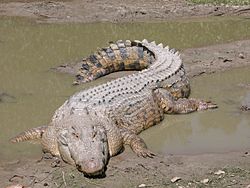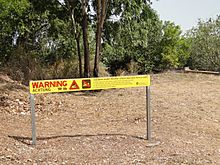Saltwater crocodile facts for kids
Quick facts for kids Saltwater crocodile |
|
|---|---|
 |
|
| Scientific classification | |
| Kingdom: | |
| Phylum: | |
| Class: | |
| Order: | |
| Family: | |
| Genus: | |
| Binomial name | |
| Crocodylus porosus |
|
The saltwater crocodile (Crocodylus porosus) is the largest of all living reptiles. They are amphibious, living in sea water, in rivers, and on land. When using weight as a measurement, it is the third-largest amphibious animal, after the bull (male) elephant seal and the walrus.
Salties, as they are commonly called, are found in Northern Australia, New Guinea, some parts of Southeast Asia, and the surrounding waters. They live in habitats near the coast: rivers, swamps, billabongs, beaches, and sometimes the open sea.
Contents
Description
The saltwater crocodile is a large reptile, growing to about 16 ft (4.9 m) in length. The males are bigger than the females, with some rare individuals as long as 23 ft (7 m). They can weigh up to 3,000 lb (1,400 kg). They have a powerful tail which helps with swimming. They have a wide snout, with big scales making two rows down their neck and back.
Saltwater crocodiles are now a protected species in Australia. Hunting crocodiles is illegal. However, if humans are at risk of being attacked, the crocodile is moved to avoid possible harm. Many years ago, Australia used to export crocodile skin. Between 1945 and 1958, more than 87,000 skins were exported. Crocodiles became so scarce that hunters had difficulty finding any. They were protected in Western Australia in 1969, the Northern Territory in 1971, and Queensland in 1974. There are now farms to breed crocodiles for the skins to make leather, meat, and Chinese medicines.
Reproduction
Saltwater crocodiles reproduce during the wet season, from November to March in Australia. There is a complex mating ritual which includes them rubbing their heads and bodies together before they mate in the water. The female builds a nest with plants that she breaks off with her teeth and then pushes together with her back legs. A female crocodile can lay up to 60 eggs at a time. These eggs are large with hard shell. They take about three months to hatch. If the temperature in the nest is less than 89.6 degrees Fahrenheit (32 degrees Celsius), the baby crocodiles will be female. If the temperature is between 89.6 and 91.4 degrees Fahrenheit (32 and 33 degrees Celsius) the babies will be male. When the crocodiles hatch out of the eggs, the mother will carry them in her mouth to the water. Few of them survive in the wild and grow to be adult crocodiles.
Behavior

Saltwater crocodiles can be dangerous (and very aggressive) to both humans and other animals. They can move quickly in the water and on land. Sometimes they kill a person, but this does not happen very often. Usually, there are "No Swimming" signs near areas with high crocodile activity. Crocodiles can lie very still for up to one hour. They can leap as high as 7 ft (2 m). In March 1987, a Toyota land cruiser collided with a crocodile at Cahill's Crossing on the East Alligator River. The crocodile knocked the vehicle off the road with its tail.
Crocodiles can also live in fresh water. Scientists have found crocodiles up to 145 miles from the sea.
Diet
Saltwater crocodiles can go a long time without eating. When it is time for them to eat, they catch fish, crustaceans, birds, or grazing animals that have come to the water to drink. The size of prey taken depends on how large the crocodile is.
Interesting facts about saltwater crocodiles
- Adult saltwater crocodiles have about 68 teeth.
- A crocodile’s jaws can apply 5,000 pounds (2.5 tons) of pressure per square inch. It has the highest bite force of any animal.
- If a tooth falls out or breaks, another one will grow in its place.
- Crocodiles cannot sweat, so they have to cool off by sitting near a riverbank with their mouths open.
- Crocodiles drag their prey underwater, but they are not able to swallow underwater, so they eat above water.
- When salties sleep, they shut down one half of their brain and keep the other alert to any nearby danger.
- The saltwater crocodile has salt-excreting gland located under the tongue that makes it able to live in salt water.
- The saltwater crocodile communicates by using chirping and growling sounds.
- Crocs can hold their breath underwater for more than an hour.
- Crocodiles swallow small stones to improve digestion. These stones help grind up the food in their stomachs.
- Crocodiles have the most acidic stomach of any vertebrate. This is because they digest the bones, hoofs, horns, or shells of their prey.
Images for kids
-
Saltwater crocodile skull from The Museum of Zoology, Saint Petersburg. Note the considerably more slender skull of a gharial in the background.
-
Saltwater crocodile tracks in East Timor
-
Saltwater crocodile jumping up at Adelaide River
-
On a beach in Darwin, Australia
-
No Swimming sign used by Parks and Wildlife Commission of the Northern Territory
See also
 In Spanish: Crocodylus porosus para niños
In Spanish: Crocodylus porosus para niños




















